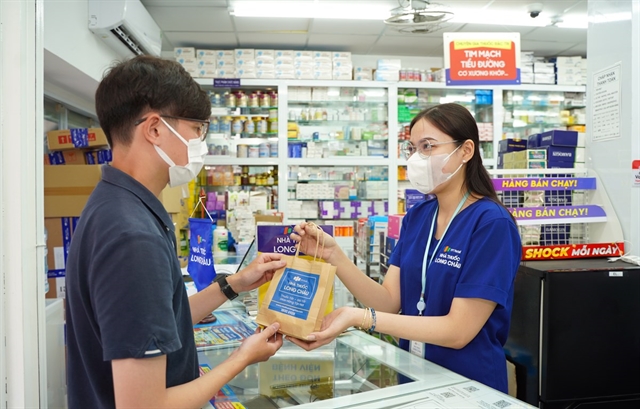 Economy
Economy

 |
| A customer at a store of Long Châu pharmacy chain. As of December 2022, Long Châu pharmacy chain of the FPT Digital Retail Company (FRT) ecosystem has officially over 1,000 stores, covering 63 provinces and cities in Việt Nam. — VNA/VNS Photo |
HÀ NỘI — In the context of rising inflation, many retail businesses can continue to grow thanks to bolstering their activities in the pharmaceutical sector.
The pharmaceutical retail network has expanded strongly. According to market research organisation IQVIA, Việt Nam had 55,300 drug stores in 2016, with 185 stores belonging to modern drugstore chains. In 2021, the total number of drug stores decreased to 44,600, but the number of stores belonging to modern pharmacy chains increased to 1,600.
In 2022, the number of large modern drugstore chains continued to increase. As of July 2022, the number of stores of the Pharmacity chain increased by more than 40 per cent, those of the Long Châu chain surged by more than 70 per cent, and those of the An Khang chain nearly doubled compared to the previous year.
Many new companies have also entered the market, including Wincommerce which owns the Winmart convenience store chain of 3,000 stores, and Viettel, which owns a retail network of 370 telecommunications stores.
As explained by SSI Securities Company, modern-model pharmacies are gaining market share from traditional pharmacies, as the Government gradually introduces stricter regulations for pharmaceutical retailers, imposing stricter control over medicine bought with a prescription.
The increase in consumption of vitamin products or supplementary foods during the COVID-19 pandemic also accelerated the opening of pharmaceutical retail stores.
Currently, drugstore chains have also diversified their product portfolios including other fast-moving consumer goods such as personal care products, cosmetics, confectionery and beverages, thereby increasing revenue and profit.
Although consumer spending is clearly affected by rising inflation, spending on pharmaceuticals is likely to remain stable due to the necessity of products, SSI Securities Inc experts said.
On this basis, pharmacy chains will be able to pass on the increased costs to customers. Drugstore chains that are actively opening new stores can negotiate better terms with suppliers, which in turn can increase margins.
As of December 2022, Long Châu pharmacy chain of the FPT Digital Retail Company (FRT) ecosystem has officially surpassed 1,000 stores, covering 63 provinces and cities in Việt Nam, exceeding 125 per cent of the plan in 2022. FRT also expects to increase the total number of stores to 3,000 in the next five years.
Analysts of MB Banking Securities (MBS) expect that while FRT's phone business segment is slowing down due to market saturation, the pharmaceutical segment will drive FRT's profit growth in the long term.
FRT will continue to open Long Châu pharmacy stores because the proportion of modern pharmacies in pharmaceutical retail is currently only about 5 per cent and Long Châu pharmacy chain has now recorded a net profit.
An Khang pharmaceutical retail chain managed and operated by Mobile World Investment Company (MWG) has witnessed strong expansion, from 178 stores in 2021 to 529 stores in 2022. In 2023, An Khang is expected to continue to expand its scale.
With MWG's advantage of having a customer base from its technology and consumer electronics supermarket chains, An Khang can benefit to increase cross-selling of products, thereby increasing profit margin.
According to the General Statistics Office, the index of industrial production (IIP) in 2022 was estimated to increase by 7.8 per cent; in which, the production of drugs, pharmaceutical chemicals and medicinal herbs had a high growth rate, at 19.2 per cent.
Analysts said that this was a big space for many retail businesses to continue to grow thanks to operating the pharmaceutical segment.
A survey conducted by Vietnam Report Company (Vietnam Report) shows that the number of health expenditures increased from US$16.1 billion in 2017 to more than $20 billion in 2021, expected to reach $23.3 billion in 2025 and $33.8 billion in 2030, with a compound growth rate from 2020-2030 of 7.6 per cent.
Việt Nam is also one of the countries with the fastest aging population in the world. Consumers' awareness of healthcare is increasing and people's incomes are rising, leading to more spending on healthcare and pharmaceutical products per capita.
However, General Director of Vietnam Report Vũ Đăng Vinh said the top four challenges affecting production and business activities of pharmaceutical and healthcare enterprises were increased logistics costs, competition among enterprises in the industry, cost of raw materials and pressure from rising exchange rates. — VNS




